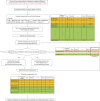Propensity score matching as an effective strategy for biomarker cohort design and omics data analysis
- PMID: 38696425
- PMCID: PMC11065211
- DOI: 10.1371/journal.pone.0302109
Propensity score matching as an effective strategy for biomarker cohort design and omics data analysis
Abstract
Background: Analysis of omics data that contain multidimensional biological and clinical information can be complex and make it difficult to deduce significance of specific biomarker factors.
Methods: We explored the utility of propensity score matching (PSM), a statistical technique for minimizing confounding factors and simplifying the examination of specific factors. We tested two datasets generated from cohorts of colorectal cancer (CRC) patients, one comprised of immunohistochemical analysis of 12 protein markers in 544 CRC tissues and another consisting of RNA-seq profiles of 163 CRC cases. We examined the efficiency of PSM by comparing pre- and post-PSM analytical results.
Results: Unlike conventional analysis which typically compares randomized cohorts of cancer and normal tissues, PSM enabled direct comparison between patient characteristics uncovering new prognostic biomarkers. By creating optimally matched groups to minimize confounding effects, our study demonstrates that PSM enables robust extraction of significant biomarkers while requiring fewer cancer cases and smaller overall patient cohorts.
Conclusion: PSM may emerge as an efficient and cost-effective strategy for multiomic data analysis and clinical trial design for biomarker discovery.
Copyright: © 2024 Maekawa et al. This is an open access article distributed under the terms of the Creative Commons Attribution License, which permits unrestricted use, distribution, and reproduction in any medium, provided the original author and source are credited.
Conflict of interest statement
Masaki Maekawa, Atsushi Tanaka, and Makiko Ogawa declare no conflicts of interest related to this study. Michael H. Roehrl is member of the Scientific Advisory Boards of Azenta Life Sciences and Universal DX. None of these companies had any role in design, execution, data analysis, or any other aspect of this study. This does not alter our adherence to PLOS ONE policies on sharing data and materials.
Figures





References
-
- <References>. Rosenbaum P.R. and Rubin D.B., The central role of the propensity score in observational studies for causal effects. Biometrika, 1983. 70: p. 41–55.
Publication types
MeSH terms
Substances
Grants and funding
LinkOut - more resources
Full Text Sources
Medical
Miscellaneous

